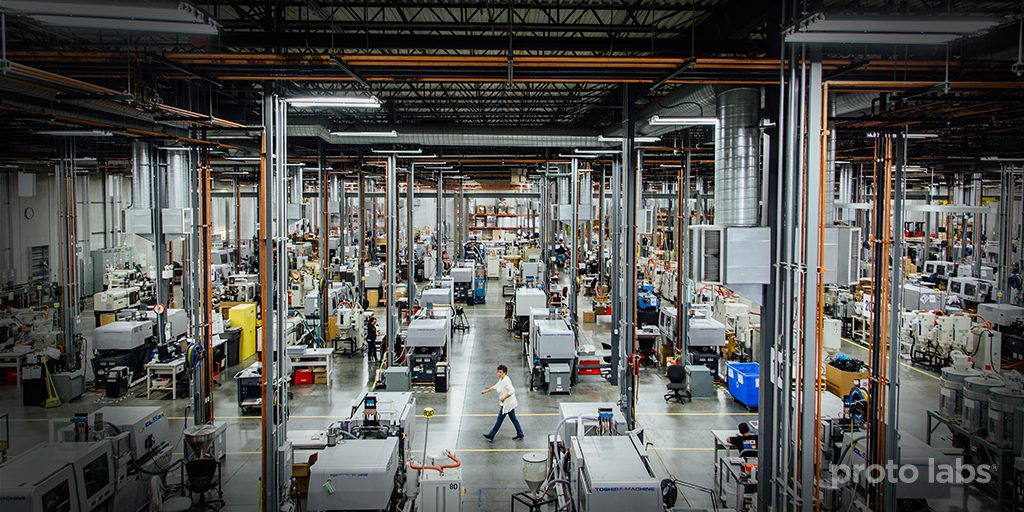3D Printing Industry is taking an in depth look at how additive manufacturing is moving to production. Over the coming weeks the results of interviews with industry leading practitioners will be published.
This article is part of a series examining Trends in Additive Manufacturing for End-Use Production.
Greg Thompson is currently the global product manager for 3D Printing at Proto Labs. Thompson has held product leadership roles at General Mills, Polaris, and Andersen Windows along with running his own successful product consulting business. Thompson holds a Bachelor of Science in civil engineering, Master of Science in engineering management and Master of Business Administration in engineering and finance.
3DPI: What is your percentage estimate of how much your printers are used for production versus other applications?
Greg Thompson: Currently, most of the applications that we support are for prototyping. However, as knowledge and use of 3D printing expands, we are seeing an increased interest in production and end-use parts.

3DPI: Which industries/verticals are leading in the use of AM for production?
GT : The industries that are currently leading the exploration of additive manufacturing for production are aerospace, medical, automotive and consumer/electronics. However, we’ve seen interest across a wide variety of industries from consumer products, to manufacturing and industrial equipment. Most engineers and program managers are at least considering additive manufacturing as an option for how they’ll design and manufacture their products.
3DPI: Are there any notable trends in AM for end-use production?
GT: Companies that are most successful in leveraging 3D printing are those that are seeking to enable new designs or design cycles previously unachievable via conventional methods. Some common design goals include reducing the number of assemblies and printing them as a single part; improving part performance by leveraging complex geometries or organic surfaces; or reducing the overall weight and materials used with lattice-type structures in lieu of solid components.
Fundamentally, if a part is hard to make traditionally, it’s likely a good candidate for 3D printing. If a design is impossible to make any other way, it’s the perfect candidate for 3D printing.

3DPI: What barriers does AM face for production and how are these surmountable?
GT: Our customers, especially those newer to 3D printing, are still validating the process overall and getting an understanding of its speed, repeatability and reliability, especially for critical end-use components.
Of course, any decision about which manufacturing process to use is really a conversation about economics. The biggest barriers to broader adoption of additive manufacturing are generally around the total costs and value that companies can create with 3D printing compared to other methods.
From a broader 3D printing perspective, these economics can improve greatly with continued machine and material advancements. We expect that to be realized in time, especially with the recent commitments and investments by large organizations, such as GE and HP. There has also been a lot of focus in the industry on reducing the labor required to support 3D printing, such as software addressing setup and automation of the post-processing currently required.
3DPI: Can you name any specific case studies where AM is used for end-use production?
GT: We are seeing 3D printing techniques in end-use production for:
- Medical Device: Custom-made implants – using the same type of part with a different design each time; production implants, spinal applications, and complex standard implants .
- Industrial Equipment: Small air tubes make for a complex design that’s not producible with other technologies
We also have a case study here.
3DPI: Are there any other aspects of 3D printing for production that you would like to highlight?
GT: We believe that 3D printing should be influencing both design and production. Businesses often make the mistake of considering 3D printing for the simple replacement of an existing manufacturing technology, and this usually doesn’t work. If the business is not considering fundamentally different processes or part designs, it will miss out on much of the benefit and opportunities for overall cost reduction and value enhancement.
With the explosion of new, innovative technologies and an increasing rate of adoption by our customers, it is an exciting time to be a part of the 3D printing industry.
This article is part of a series examining Trends in Additive Manufacturing for End-Use Production.
If you found this insight useful, then why not subscribe to our newsletter and follow us on social media.
Featured image shows a Proto Labs 3D printed demonstrator. Photo by Michael Petch



